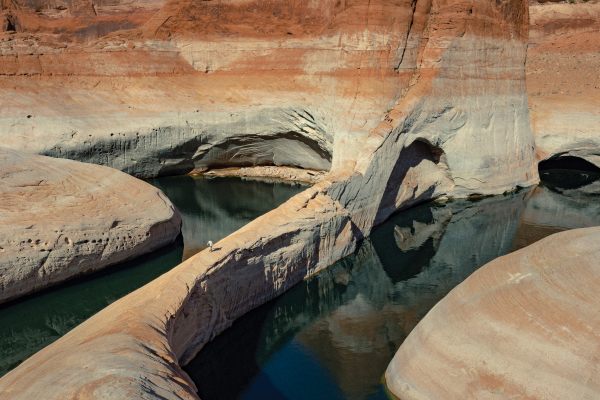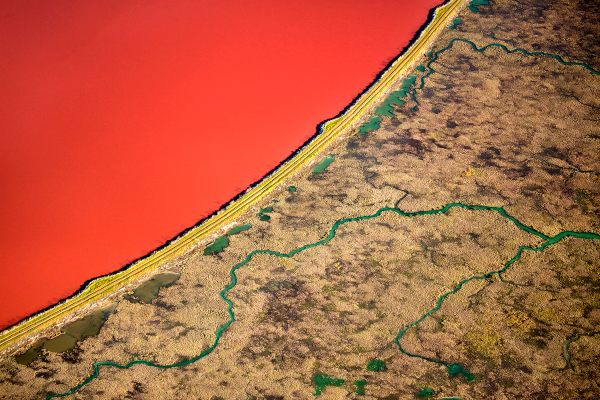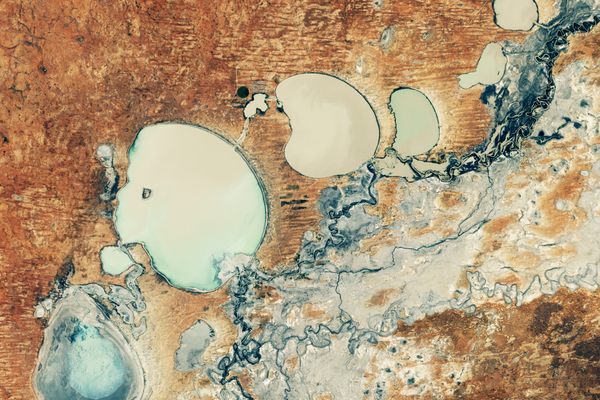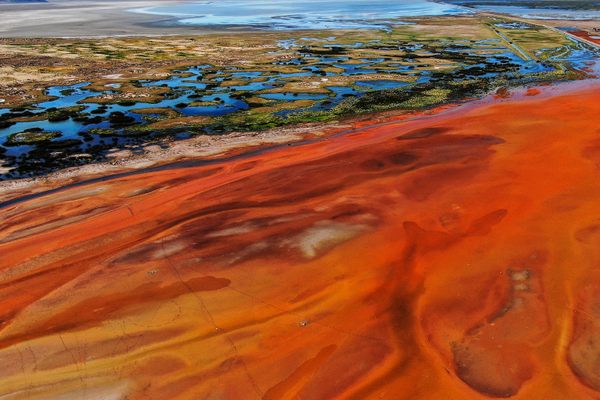
From Mining Hellscape to Holiday Paradise
How Germany’s Lusatian Lakes District is remaking an entire region through broad-scale landscape re-engineering.
Near the harbor of Großräschen, a small town in Brandenburg, Germany, you can walk through the stately entrance of the Seehotel and place a two-euro coin on the front desk. In return, a receptionist will lead you behind a locked door, where you can see the Mona Lisa.
A few rooms on the ground floor of the hotel are filled with paintings by the Posin brothers, a trio of Russian artists who copied the Old Masters in their studio in nearby Berlin. Their fake Rembrandts, Gaugins, El Grecos, Klimts, and Leonardos crowd red walls in dignified gold frames. The Mona Lisa even has a protective case.
The little museum’s cheerful promise is to be “Deceptive but not disappointing!” It could hardly be located in a more appropriate place, and not just because one still expects a little kitsch in what used to be East Germany. When the Seehotel opened in 2007, the name (literally “Lake Hotel”) was entirely optimistic. There was no lake. There was only a shallow puddle in the crater of the Meuro open-cast brown coal mine, where operations had ceased in 1999. But after years of intentional flooding, Großräschen Lake recently reached its final water height, and the hotel now finally lives up to its name. The water of the lake is just around the corner from its front entrance. It is just one in a collection of deceptive, unfinished masterpieces that make up the Lusatian Lakes District, or Lausitzer Seenland.

Over two centuries, coal mining completely changed the face of Lusatia, which straddles the states of Brandenburg and Saxony southeast of Berlin. The region was once largely rural, dotted with villages dating back to the Middle Ages and known for its population of Slavic-speaking Sorbs, an ethnic minority in Germany. But then strip mines consumed about 60 percent of the land. As the region became a moonscape, it supplied 90 percent of East Germany’s electricity and heated the country’s homes. Now, more than 30 years after the fall of the Berlin Wall, Lusatia is in the midst of another radical transformation. The coal-mining industry is on the path to extinction—not without controversy—and tourism is being touted as one of its hopeful economic replacements. Inside the biggest exhausted Lusatian strip mines, there are now more than 20 new artificial lakes like Großräschen Lake, many of them connected by canals, covering around 60 square miles. Surrounding those waterways are a variety of new biomes—wet heaths, sandy grasslands, pine forests—as well as new cycling trails, hotels, campsites, harbors, dive shops, and all the other trappings of a German holiday hotspot. The Lausitzer Seenland bears the weight of a lot of superlatives—Germany’s largest lakes district, Europe’s largest artificial waterscape, the biggest landscape-construction site in Europe.
When I stepped outside the Seehotel in summer 2018, I walked by potted palm trees that decorate the promenade overlooking the new lake harbor. The opposite shore’s barren scarp looked downright Mediterranean. On the slope leading to the water, I spotted a vineyard. It was hot enough to tempt even the most reluctant bather, but the harbor was still empty, because at the time swimming was still forbidden and the planned beach still had no sand. Only barges swam the lake, tending to unruly shoals of vegetation piled up by currents. I encountered just a few groups of curious tourists, mostly Germans, who seemed to be less vacationing than prospecting for fun futures. I yielded to a family on bikes as I walked to the end of a pier made from repurposed mining equipment, like the landscape itself a monument to the area’s industrial heritage.
Germany has a reputation as a leader in clean energy, and yet the country is the world’s biggest producer of brown coal, or lignite. Cheaper, softer, more polluting, and less efficient to burn than hard coal, brown coal contributes a fifth of Germany’s overall emissions. Lusatia is one of Germany’s three major lignite regions. (The other two are in Central Germany around Leipzig and further west in the Lower Rhine basin.) Brown coal has been mined in Lusatia since the middle of the 1800s. Lignite is the youngest form of coal and thus closest to the surface. With the industrial age came the creation of expansive open-cast mines—mining from open, terraced pits as opposed to, say, tunnels. After World War II, the German Democratic Republic—GDR or simply East Germany—kicked production into high gear. The smell of brown coal became the smell of East Germany. Green meadows, agricultural fields, and about 130 villages were razed to make way for mines. Despite those displacements, the population of the region expanded, as people were drawn by the promise of employment.
But then, in November 1989, the Berlin Wall fell. As Germany was reunified, mines once operated by the East German government were suddenly without an owner. Some were taken over by corporations, such as the Swedish national utility Vattenfall. Others were abandoned, as the demand for brown coal dropped drastically. According to German newspaper Die Zeit, around 800,000 people left East Germany for the West in 1989 and 1990 as factories and other industries closed and unemployment rose. Lusatia, which had a highly specialized mining workforce, was hit particularly hard. One of the biggest cities, Hoyerswerda, had a peak population of 70,000. Today it’s around 40,000.

As for the wounded landscape, the reunified German government had quite a task on its hands, with more than half of the old mining sites still needing to be reclaimed in some fashion. From the 1990s through 2016, the government spent the equivalent of 10 billion euros on the landscape overhaul in Lusatia. Another billion will be spent through 2022. Returning the place to nature, or some copy of nature, isn’t simple, and the stakes are high: Now that Germany has committed to getting rid of its coal industry within the next two decades, the Lausitzer Seenland is more than a reclamation project—it’s a test-case for the future of energy.
At least for now, visitors can still get an intimate look at Lusatia’s coal industry before it vanishes. Operated by Czech energy company LEAG, Welzow-Süd is one of the few lignite mines still active in the region, and the local mining tourism association offers a variety of tours of the pit. They depart from Gut Geisendorf, a 17th-century manor turned cultural center in Neupetershain, surrounded by the greenery typical of the Brandenburg countryside. That idyll ends abruptly just 300 feet from the manor, where the ground opens up to desert-like badlands. The contrast is so thrilling and unsettling that it was easy to see why, even just aesthetically, creating expensive artificial lakes would be preferable to leaving these apocalyptic landscapes as they are. Like the other tourists, I picked up a hard hat and boarded a tank-like truck.
We drove by mountains of disposal dumps that resemble crumbling sandcastles and heard the hum of bucket-wheel excavators sculpting the earth in neat patterns in a full palette—from beige to dark brown. At the end of a bumpy and winding ride to the floor of the mine, we hopped off the truck in front of the star of the tour: an overburden conveyor bridge F60, the largest moving machine in the world. Five of these behemoths were built in Lusatia. One that was abandoned in the 1990s after its mine closed was adopted by the town of Lichterfeld, and as of last year, you can go kayaking or swimming at the new Bergheider Lake with that F60 as a backdrop. The machine’s nickname is the “Horizontal Eiffel Tower of Lusatia.” If the real Eiffel Tower had somehow tumbled into an empty pit, it would be 600 feet shorter than what appeared before us in Welzow-Süd. But using that French icon as a metric appears to be a local custom; a short drive away is Tropical Islands, a water park inside a defunct airship hangar that boasts being big enough to contain the Eiffel Tower lying on its side. In any case, the metaphor doesn’t do the F60 justice, as the Eiffel Tower doesn’t chew up and spit out the ground beneath it.
In Lusatia the coal seams may be buried 200 feet below the surface. Overburden conveyor bridges strip the upper layers of sand and dirt and carry them away. The F60 has nine moving belts that can move more than a million cubic feet of earth each hour, the equivalent of a football field buried 25 feet deep.

I craned my neck to look at the creaking machinery, then turned my eyes to the ground. As I picked up what looked like brittle, shimmering strips of bark and broken bits of logs from a recently extinguished campfire, I felt suddenly embarrassed that until now, I had a much more abstract idea of what a fossil fuel actually is. During the Miocene, more than 15 million years ago, Lusatia was warmer and wetter than it is today. Dead branches, fallen tree trunks and other decaying organic matter sank to the bottom swamps and, eventually, were buried beneath heavy layers of sand and clay. The process, spanning millions of years, converted the fossils into fuel—soft lignite. It makes the idea of tearing open a mine and then rebuilding a new landscape in its place within a few decades seem a laughably ambitious proposition.
“What happened there is comparable to what happened during the Ice Age,” hydrologist Martin Schultze says later over the phone. In his analogy, the mining machines in Lusatia are like the prehistoric glaciers that carved holes into Europe as they shifted around. Now many parts of the region are essentially in their post-melt phase, with machines disappearing, leaving holes and possibly lakes behind. Schultze says he had many sleepless nights when he was advising the Lausitz and Central-German Mining Administration Company (LMBV), the federal authority set up in 1994 to take charge of the “recultivation.” He knew that the lakes forming in Lusatia now might exist for thousands of years. “That is a huge opportunity for making a completely new landscape, but also a huge responsibility.”
Allowing groundwater to naturally fill in a mining void in Lusatia would take more than 100 years, and even then a lake might not be a guaranteed result. Lusatia is one of the driest regions in Germany, where water generally evaporates at a higher rate than annual precipitation. What’s more, millions of gallons of water were pumped out of the ground over decades of heavy mining, creating a severe groundwater deficit. To fill and replenish the aquifers and lakes, water is being diverted from other sources, such as the Spree River, which flows northwest to Berlin. It’s not enough, however, just to bring the water in. When minerals in the soil, such as pyrite, react with oxygen, they can create sulfuric acid, which seeps into the water bodies. Left alone, the lakes would be as acidic as vinegar, viable for neither marine life nor waterskiers. The LMBV has had to devise complex strategies to neutralize the water, involving vessels and stationary plants that deposit alkaline substances, such as caustic lime, chalk, and soda, which increase the pH to around 7.0 and can make the water occasionally look turquoise. The tourism board sometimes puts out a notice that a big lime dump is happening in a lake, in case visitors want to experience a landlocked “Caribbean feeling.”
The Lausitzer Seenland now has about 1,200 miles of greenways, many of them newly paved. As I biked through just a fraction of them, I often got to a shoreline where I thought I might be able to take a rest, only to find another reminder that I was on what remains a large construction site: a chain link fence with a little yellow sign warning of danger. The signs are there for good reason. The towering disposal dumps I saw in the active mine really are as fragile as the sandcastles they resemble, and they make up many of the slopes surrounding the lakes. That ground can suddenly liquefy under too much pressure from construction or the penetration of a new mass of water. There are a few ways to prevent such a spectacular collapse. To consolidate the soil, engineers can detonate explosives at strategic points underground, or use the vaguely suggestive process of vibro-compaction, by which a giant, vertical dangling vibrator wiggles and thrusts through the earth, compressing the soil, sometimes while jetting water or compressed air in its path. In Lusatia, this vibrator sometimes has to go as much as 180 feet deep. These underground compression strategies essentially make hidden dams that buttress the soil to keep it from sliding. However, these high-tech and expensive methods aren’t guarantees.

On an October afternoon in 2010, landscape planner Alexander Harter witnessed this firsthand. He had received a call from a local shepherd urging him to come quickly to the edge of newly created Bergener Lake. The ground had started to move, and suddenly a mega-landslide tore a mile-long gash in the shore, swallowing half the shepherd’s flock, burying three trucks, and sending up a wave nearly 10 feet high. Harter called for an emergency helicopter to pick up one truck driver who had been swept away in the muck and was shouting for help. The sheep that survived were stranded on newly formed islands in the lake and had to be rescued. No people died in the landslide, but the incident shook the community. Tourists are barred from getting anywhere near Bergener Lake and may never be able to swim in it, which ultimately may not be such a bad thing, according to Harter, who recounts the story from his office in Bergen, in the middle of the Lakes District.
Harter is the managing director of the Lausitzer Seenland Nature Conservation Project (NGP), one of the groups tending to the refurbishment of the land. Besides tourists, wildlife is also returning to Lusatia in the new landscapes sprouting up around the lake. Now, in former mining areas, there are open fields with shrikes and kestrels that snatch up prey from the air, as wolves and deer roam the edges. Sandy dunes and dry grasslands are now home to woodlarks, fallow pipers, butterflies, and tiger beetles. The NGP assists some species, placing nesting boxes around meadows for flamboyant Eurasian hoopoe, for example. Sometimes the birds assist right back: Jays collect acorns from wooden boxes and bury them underground as food storage for the winter, and their forgotten deposits occasionally grow into oak trees, a naturalistic touch for new forests, some of which are so new they can look like Christmas tree farms.
The adjustment is much more contentious for Lusatia’s human population. The operating mines are still eating up villages; a few hundred people will be relocated from the small town of Mühlrose as LEAG’s Nochten open-cast mine expands before its inevitable shutdown. Earlier this year, Germany pledged that it would phase out coal production by 2038 as part of its larger strategy to have net-zero emissions by 2050. Some climate analysts are skeptical that this would really help reduce carbon dioxide emissions for Europe as a whole, and activists are adamant that such steps are insufficient to avert environmental disaster. In November 2019, thousands of protesters stormed Welzow-Süd and other mines in Lausitz to demand an immediate coal phase-out. As part of the current plan, coal-producing regions will get €40 billion to support “restructuring” over the next 20 years. Nearly half will go to Lausitz alone.
Despite promises of support from the government and retraining programs—some in the tourism industry—there is concern about a lack of local well-paying jobs and the loss of the coal industry. In the heyday of brown coal, the region’s mines employed about 140,000. Now, according to Deutsche Welle, there are just 8,000 brown coal workers in the region. “Miners do not become seamen overnight,” says Kathrin Winkler, head of the Lausitzer Seenland tourism association. Winkler, who grew up in Lusatia and once worked in coal sales herself, thinks changing the identities of the people of Lusatia may take longer than any of the changes visible in the landscape. The far-right Alternative for Germany (AfD) party—which has strongly opposed the coal phase-out and rejects the overwhelming consensus among scientists that climate change is a human-caused problem—has seized on this precarious situation. They’ve gained more support in former East Germany than other regions of the country.
“Politicians didn’t understand that well-being is more than having everything you need,” architect Karsten Feucht says. For him, the transformation of Lusatia also goes far beyond changing the landscape and the economy. “It’s a cultural transformation,” he says. “And people need help.” Feucht was part of an effort to kickstart that cultural change under Germany’s Internationale Bauausstellung (IBA). From 2000 to 2010, IBA initiated 30 projects in the Seenland, including the construction of floating houses on some of the new lakes, a sports center, and a sleek new harbor in Lake Senftenberg, the Seenland’s first artificial lake, created in the 1970s, which most convincingly looks like a lively holiday destination today. But IBA also sought to preserve much of the industrial heritage of Lusatia. They helped save towers from a historic lignite coking plant. An IBA competition resulted in the construction of a 100-foot-high steel staircase, nicknamed “The Rusty Nail,” where visitors can climb to the top to look out over three lakes, with several power plants on the horizon. Feucht even had a provocative idea for Welzow-Süd after it shuts down sometime in the 2030s: Keep the mine looking much like it does today, as a desert, with an artificial oasis in the center. Alas, it was a little too provocative, and the community shot the proposal down.

Winkler says the Lausitzer Seenland is now recording about 800,000 overnight visits each year but their goal is to eventually reach 1.5 million. The 2020 tourism season is now underway in the midst of the global pandemic, and Winkler said it’s too early to see any changes in the number of visitors. Lusatia may be insulated from much of the havoc COVID-19 has unleashed on the international travel industry, as the majority of visitors come from within Germany. COVID-19 infection rates have significantly dropped off in the country, and restrictions on domestic leisure travel have been eased. The share of international visitors mostly comes from Poland and the Czech Republic, and the borders between the countries opened on June 15. A few months of disruption is a blip compared to the timescales that govern change in Lusatia. “Ten years is a blink of an eye here,” Winkler says. Tourism managers have been trying to promote the lakes as a new alternative to better-established domestic destinations in eastern Germany, such as the windswept beaches along the Baltic Sea and the Spreewald, a quaint region just north of Lusatia famous for its canals and pickles. They’ve embraced the weirdness of a landscape-in-progress as part of Lusatia’s appeal, promising tourists a first look at the ruins, or almost ruins, of the coal industry—all while the people who live there are still figuring out what the future will look like.
Similarly, the museum of fakes in the Seehotel is not completely committed to deception. On one wall there is an array of international news clippings and magazine features about the Posin brothers. They are nearly identical and deadly serious in every photo, distinguished mostly by their hairstyles and props. (Eugene, for example, has a triangle of curls and always carries a pipe.) I thought they sort of resembled Van Gogh; it couldn’t be a coincidence that their copy of his last self-portrait, with its studiously textured blue swirls, is one of their best. It’s possible that visitors to Großräschen a hundred years from now won’t be able to detect a whiff of strangeness or artificiality in this lakeside vacation town. But just as no one should come here to study Van Gogh, no one should come to Lusatia expecting to veg out in unspoiled nature right now. It’s a better destination for those who want to look at the unreal blue swirls left by a water treatment barge and think about millions of years of geologic processes, supremely big machines, billions of euros, and the hundreds of thousands of people that make such a vacation paradise possible.


















Follow us on Twitter to get the latest on the world's hidden wonders.
Like us on Facebook to get the latest on the world's hidden wonders.
Follow us on Twitter Like us on Facebook